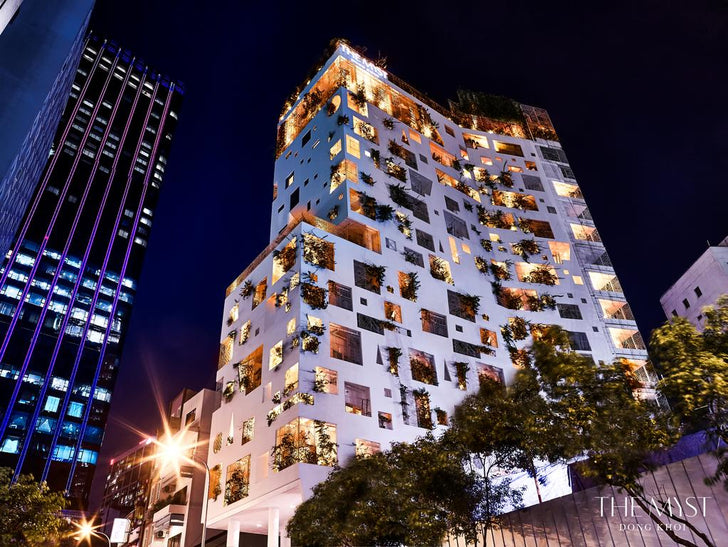The Design of Ho Chi Minh’s Myst Dong Khoi Hotel

Located in the heart of Ho Chi Minh City, the Myst Dong Khoi stands out as a peculiarity at first. Its irregular façade with oddly shaped and unevenly spaced windows creates a contrast against the emerging skyline composed of the nearby highrises. It is behind this exterior, however, that the hotel’s full story is unveiled in its most complete form. A depository of memories and a showcase of local artisanship at once, the Myst puts a contemporary spin on local traditions, evoking nostalgia through its bold design.

Designed by the Vietnamese architectural firm A21 studio, the 18-story hotel unfolds as a journey of discovery of the city, integrating local icons and cultural references that position Saigon not only as an emerging metropolis but as a culturally rich city, too. Beyond simply conveying the local charm of Ho Chi Minh City, A21 studio’s architect Nguyen Hoa Hiep sought to preserve the disappearing traditions and cultural vestiges of Saigon that are slowly giving way to rapid urbanization.
Hong Nam, hotelier and chairman of Vietnam’s Silverland Hotels & Spas Vu, which manages the Myst Dong Khoi, says that preserving the culture and the history of the city was always the primary aim of the hotel’s design: “Saigon is a warm-hearted, generous city with vibrant energy and rich heritage. We created the Myst, a modern sanctuary that tells the story of Saigon then and now, as a way to give back to the city.”

Throughout the property, a deliberate departure from a typical hotel typology draws curiosity and a sense of exploration. The hotel’s winding corridors with concrete ceilings and exposed sprinkler pipes are more reminiscent of the Saigon streetscape than a traditional hotel hallway. “Forms, space, and colors of the hallways remind people of small alleys in Saigon, mirroring the city’s twists and turns,” explains Hiep.

Similarly, in the lobby and at the outdoor café, Hiep integrated industrial parts and scraps salvaged from the demolished 200-year-old Ba Son Shipyard across the river to provide a glimpse of the real Saigonese history. Rooms, too, take cues from the traditional layouts of typical Vietnamese houses, complete with outdoor showers and small gardens that grow a variety of tropical flora that partially shield city views for more privacy.

Basic, vernacular materials like brick, tile, concrete, and wood instill a deeper sense of place as well as context within the Myst’s interiors, showcasing the humble, locally sourced products and craftsmanship. “Furniture and kitchenware in bedrooms are all handmade and can be easily found in the south of Vietnam,” says Hiep. “All together, these make up a welcoming atmosphere and showcase Saigon’s simple charms and rich traditions. In this way, the Myst is a gratitude to our beloved Saigon.”
Olha Romaniuk for HospitalityDesign • March 13, 2018
I visited Ho Chi Minh for the first time a year ago. I really didn’t know what to expect from the quiet communist country that for most Americans represents a failed war that’s left indelible scars on the lives of everyone touched by it, but traveling has taught me that every country is full of beautiful, rich living experiences and kind, generous people. Vietnam is all of that in abundance.
The prolific layering of communist utilitarianism, French colonial architecture, and a modern Asian cafe culture all wrestling and intermingling with the invasive southeast Asian tropical vegetation create a bustling but wildly balanced city with everything to offer. For me, the best of this remarkable city is the Myst Dong Khoi, which quickly became one of my all-time favorite hotels.
From the cool concrete walls offering respite from the wet heat of the city, to he referential carved wood accents, the private terrace tubs, and the rooftop pool, the hotel provides zen tranquility just steps away from a frantic, exciting modern metropolis
Seth, STAG & MANOR • May 31, 2018


